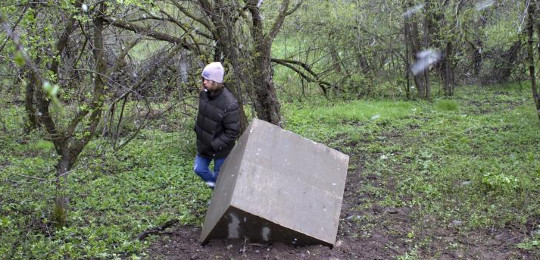T.S. Giilck
A local artist has taken a hard-line position on his craft in a new display in the countryside around Meaford.
Kaegan Walsh says he grew up in the area, and his new display is, shall we say, a concrete display of the affection he feels for his childhood home.
“I grew up in and around Meaford and I care about the community and its culture. The geologic history seen through the aggregate found in concrete is very legible in the landscape around Meaford.”
He’s installed a series of concrete cubes on a rural property on the 7th Line and Side Road 7 in an attempt to replicate nature.
“The art in this instance is both the landscape in which the concrete cubes are installed and the aggregate found within the cubes. The landscape and concrete cubes are one, and this inextricable relationship is what typically defines land art or earthworks. These abstract boulders are intended to mimic the natural boulders deposited in the region during the last ice age (approximately 10,000 years ago). In this era, an ice sheet moved through the landscape, depositing boulders along the way and grinding massive amounts of stone into what is now used for aggregate in our concrete. Our concrete constructions, such as buildings, sidewalks, highway overpasses, etc. are once again displacing the rock material created by this natural phenomenon. These unnatural abstract boulders are meant to juxtapose these natural and human geologic actions.”
“The motivation behind the project was to illustrate the link between ancient geological history and a modern building material: concrete. The key concept for this project is how an individual concrete construction can be traced back to a very specific location within the natural environment by identifying the unique stone types found in every sample of concrete that uses a natural aggregate. In this way, all concrete buildings and infrastructure, ubiquitous in our cities, can be linked to a unique origin within the landscape. Each construction can be thought of as having a distinguishing fingerprint identified by its unique stone mix. This stone mix varies from region to region, but each and every building can ultimately be identified in a very unique location geographically in its surrounding landscape. When you see a concrete building in a city or town, the stone mix it displays in its aggregate can be traced back to a unique location in the landscape.”
Walsh said he knows the project might be a tough sell for some people.
“Concrete does not always inspire a positive reaction from people architecturally,” he said. “My hope is that this project will draw attention to the historical significance this material provides to a community. Similar to communities that draw their stone from a unique rock quarry, the aggregate used in concrete also bears very distinctive characteristics.”
His hope is that people will be curious enough to seek out the ‘Provenance’ landscape art he has created.
“This project is somewhat hidden in the landscape. The contrast of these abstract, manmade boulders is powerful when witnessed in the rolling countryside outside of Meaford. These boulders have natural counterparts in the surrounding landscape and I hope that someone who visits can see the strange beauty in that these cubes both belong there but are also alien to the landscape.”
For more information, go to kaeganwalsh.com.













